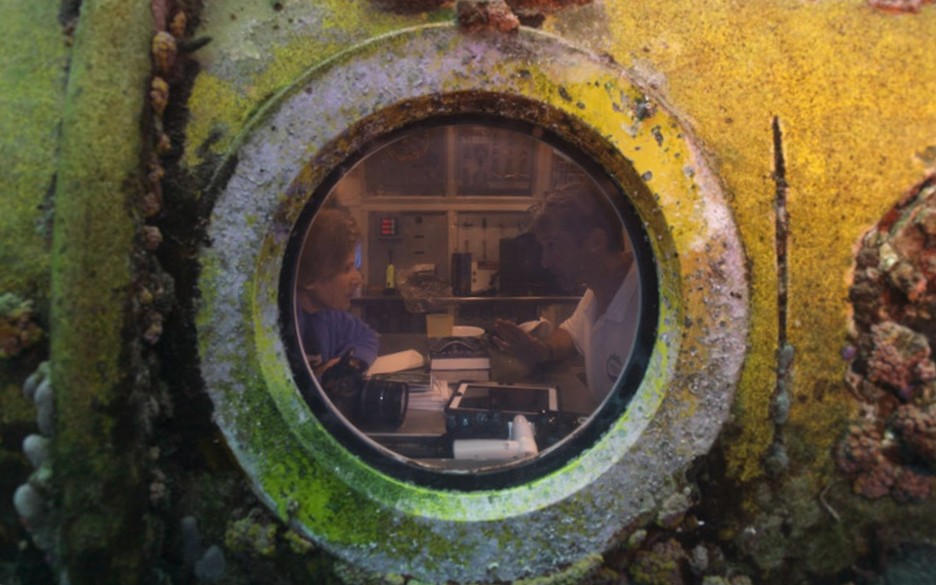Written by Catherine Guinovart
June 26, 2020
- The compound eyes of the peacock mantis shrimp
- The peacock mantis shrimp out on sand
Researchers at Aquarius have studied corals and even shrimp. In July 2001 a 10-day mission focused on better understanding the vision of mantis shrimp.
WHY DO WE CARE?
Research on mantis shrimp vision has led to the bioengineering of sensors for polarized imaging devices and analyzers. These devices have a wide range of applications including in biomedical imaging technology that can facilitate early cancer detection.
Research conducted at Aquarius has helped to build the foundation for what the scientific community knows about mantis shrimp. Without that foundation, the engineers who developed the sensors wouldn’t have been able to apply what we know about mantis shrimp vision to technology development. For example, a report about the bioengineering of polarized light systems co-authored by Thomas Cronin was based on research conducted at Aquarius.
Using highly evolved compound eyes – with up to 16 color receptors – mantis shrimp detect UV, visible and polarized light. With so many receptors, mantis shrimp can see the polarization of light with less glare and distortion. This is light that is radiating, reflected, scattered or refracted in different planes of direction.
By contrast, people have only three receptors for light absorption called cones. They allow people to only perceive red, yellow and blue wavelengths.
WHAT HAS AQUARIUS HELPED US DISCOVER ABOUT MANTIS SHRIMP?
Studies at Aquarius have compared how mantis shrimp vision – specifically the function of photoreceptors used for light absorption – varies in different species based on the light levels between different oceanic zones.
As light decreases with increasing depths, these photoreceptors are adapted to the variations. This harnesses the full capabilities of their complex visual systems including the ability to see polarized light and using fluorescence to emit light for signaling.
Fluorescence occurs when organisms absorb light, transform it and re-emit it as a different color. Like neon paint that glows under a blacklight, mantis shrimp throughout the western Atlantic have fluorescent yellow markings that appear as patches on their bodies. Studies show these play an important role in visual communication, particularly during threat displays.
Mantis shrimp collected from the reef near Aquarius have also been used to study how their compound eyes use parallel processing to analyze the images they see.
Parallel processing refers to the way visual inputs – like color and polarization – travel from the eyes to the brain. Rather than traveling on the same pathway one after the other, there are multiple parallel pathways that allow mantis shrimp to process visual inputs concurrently.
They move their eyes to absorb visual information and integrate color along with polarization in their spatial vision. After the visual information leaves the retina, it gets processed in numerous parallel data streams ultimately leading to the central nervous system. This greatly reduces the high-level analytical requirements of their vision and reduces the amount of work necessary for mantis shrimp to process what they see.
These features are unusual in the animal kingdom and are some of the most important characteristics being used to inspire new sensor designs for machine vision applicable to many industries.
HOW CAN WE HELP?
While mantis shrimp are not considered endangered or threatened, they are part of a coral reef ecosystem. All wildlife within a system play a role and even a small shift can cause an imbalance. The best course of action to conserve mantis shrimp is to protect the environment they inhabit. Some practical things we can do to help coral reefs include:
- Choosing sustainable seafood: This means eating seafood that supports a healthy ocean. Check out the Monterey Bay Aquarium Seafood Watch Guide for recommendations.
- Avoid touching corals or giving them as gifts.
- Drop anchor in sandy areas and away from reefs or seagrasses.
- Pick up at least three pieces of marine debris each time you are at the beach or on the water and volunteer in local beach or reef cleanups.
- Don’t use harmful fertilizers. Some chemicals can run off into the ocean and could harm corals or other wildlife on the reef.

More than shrimp
Mantis shrimp are just one animal studied at FIU’s Aquarius Reef Base.
In part because of Aquarius and the work of the university’s Institute of Environment, FIU was ranked No. 9 in the world and No. 3 in the U.S. by the Times Higher Education Impact Rankings on Sustainable Development Goal 14, Life Below Water.
Aquarius Reef Base has supported more than 120 missions since 1993. Dive in to see what past research teams learned and experienced along with new ways to get involved. Learn more about Aquarius and take a virtual self-guided tour of the world's only undersea laboratory.